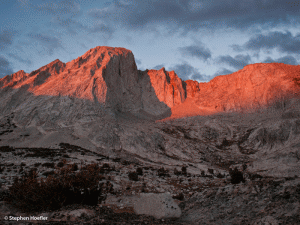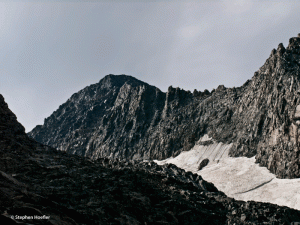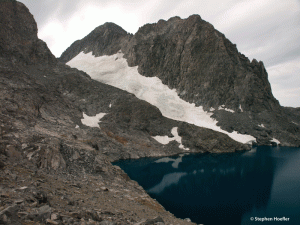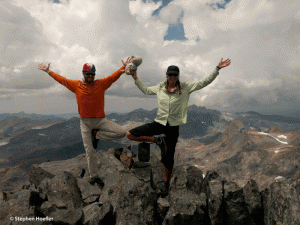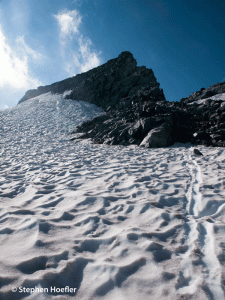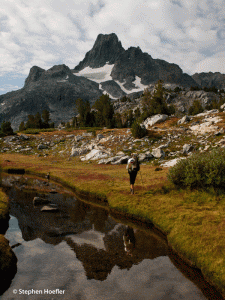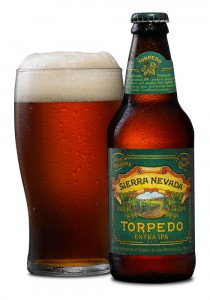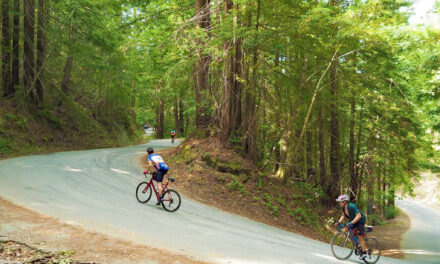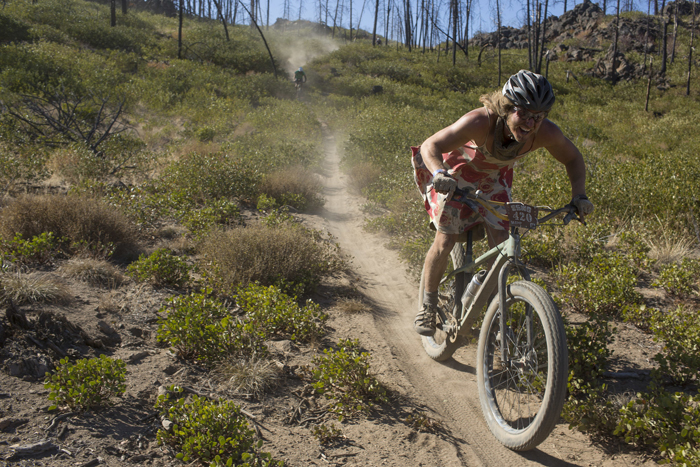- Tahoe’s Nevada Beach Tops the List of Hard-to-Book Campgrounds - 07/17/2024
- Cannabis Watershed Protection Program Cleans Up Illegal Grow Sites - 07/10/2024
- French Fire - 07/05/2024
Three Sierra Peaks in One Week
By Leonie Sherman • Photos by Stephen Hoefle
My heroes have always loved mountains. Whether putting up bold first ascents or writing poetr, the wise fools, itinerant wanderers and brilliant misanthropes I most admire draw their inspiration from rocky giants. One of these heroes, the Japanese poet Matsuo Basho, entreats aspirants: “Do not seek to follow in the footsteps of the masters. Seek what they sought.” When Steve and I set out to climb Mt Ritter, Mt Lyell and the Matterhorn as part of a weeklong adventure, we were doing both.
RITTER
Ritter looms dark and jagged above Lake Catherine, a jumbled pinnacle of metamorphic rock, the shattered remnants of a range that preceded the Sierra Nevada by millions of years. Ritter looms in the imaginations of mountaineers as well, due to the lofty summit panorama and the scary firstascent by John Muir.
In early October 1872, Muir bade farewell to his summer home in Tuolumne Meadows and began his annual winter pilgrimage to Yosemite Valley. As soon as he arrived he was accosted by a group of artists, requesting that he bring them to alpine vistas suitable for painting. Without even pausing for a hot meal, Muir turned around and led them back to Tuolumne Meadows.
There he left them and sauntered off alone, with his usual meager provisions to see if Mt. Ritter, the “king of the middle portion of the High Sierra,” was scalable. He ascended the glacier to the saddle between Banner and Ritter and began to climb the broken rock. There, spread-eagled on the rock, he faced every climber’s worst nightmare: he got gripped.
“My doom appeared fixed,” he laterrecounted. “I must fall.” He recalls becoming nerve-shaken for the first timesince entering the Sierra. Then, like Alex Honnold over a century later shaking off mental paralysis on Half Dome, Muir’s true nature blazed forth. He began climbing the rock as if guided by a divine force and reached the summit without incident.
While preparing to repeat Muir’s climb recently, I made it a priority not to experience Muir’s dramatic inner struggle. Instead, I chose to focus on the fact that 140 years ago, the man who founded the Sierra Club and almost single-handedly created Yosemite National Park, had touched the same rock.
Darkening skies set the stage for our climb up Mt. Ritter. The lowest 25 ft. of the glacier were hard ice, requiring laborious step cutting. The rest of the way we were able to do kick steps in softer snow until we reached the rock. We were delighted to discover fun, physical third class cruising with lots of positive holds and sharp edges.
Gathering clouds shortened our summit stay and rushed our descent. Just as we reached the hardest glacial ice, pellets of hail began pinging around us. We slid to the rocks below, pulled on raingear, and hurried to retrace our steps.
As we side-hilled above a steep precipice directly above Lake Catherine, I pulled a table-sized boulder off the slope and into my chest. The impact spun me around and I began surfing the ensuingrock slide. My partner watched in horror as I fell 15 vertical feet, finally skidding to ahalt against a boulder.
A week later I still have crusty scabbed knees and knuckles. Ritter filled me withhumility and my socks with rubble and blood.
Five hours of struggling through pea-sized hail past roaring ephemeral waterfalls brought us to the edge of Island Pass, where we made a soggy camp. The next morning, under billowing clouds, we followed Muir’s footpath over Donohue Pass and to the shore of a glistening lake, a burbling creek, and the headwaters of the Lyell Canyon.
LYELL
At 13,114 feet, Mt. Lyell is the highest peak in Yosemite National Park. The glacier stretching between Lyell and Maclure and onto the slabs below is second in size only to the Palisade Glacier, sixty miles to the south. The Lyell Glacier is also where Muir finallyproved his ideas on glaciation. He pounded a line of stakes into the ice and returned a year later to find a graceful curving arc.Thus he proved the river of ice theory and cast off Josiah Whitney’s label of “ignorant shepherd.”
As part of the 1863 Whitney Survey, William Brewer and Charles Hoffman made an attempt to climb the peak, only to be rebuffed 150 feet from the top. They describe their experience in typically floridprose: “We toil for hours, it seems at times as if our breath refuses to strengthen us, we puff and blow so in the thin air. After seven hours of hard climbing we struck the last pinnacle of rock that rises through the snow and forms the summit — only to find it inaccessible, at least from that side.”Despite their failure to summit, they took the liberty of naming the peak.
Eight years later a Boston businessman named John Boies Tileston made the firstascent, solo. He casually recounts his experience: “I was off at six and reached the top of the highest pinnacle before eight. I came down the mountain and reached camp before one p.m., pretty tired.”
Steve and I also set off at six a.m. and cruised the mellow approach over smooth slabs, winding among vertical meadows. Global climate change and a record low snow year allowed us to leave our ice axes behind and trust our Vibram soles in the few spots we had to cross directly onto the glacier. We were able to stay on rock and soft snow most of the way to the Lyell-Maclure saddle.
The western skyline of Lyell presents an intimidating jumble of dark broken blocks. Closer examination revealed a variety of moderate class three climbing with the option for occasional class four moves. This was followed by a stretch of talus hopping to the summit. We sat and savored the view, north to Conness and Whorl. The twin hulks of Ritter and Banner rose to our immediate south, and Steve’s eagle eyes could pick out the hazy bulk of Mt. Humphrey’s on the distant horizon.
The descent proved just as pleasurable as the approach, and like Tileston we were back in camp by 1 p.m. We enjoyed a leisurely lunch and decided an afternoon stroll down the Lyell Canyon was just the thing. Twelve miles and five hours laterwe staggered into the Tuolumne Meadows store, made hasty high calorie purchases and stumbled off into the woods to sleep.
We enjoyed a lazy morning basking in the sun in Tuolumne Meadows before beginning the ramble to our third and finalpeak. Later that day from a splendid camp at Roosevelt Lake we watched in mute awe as the alpenglow cast curtains of orange, purple and rose across the majestic west ridge and south face of Conness, the best widescreen television on the planet. The next morning we ambled over Hidden Pass, down, down, down to the PCT and up the gradual slope of Spiller Creek Canyon to Horse Creek Pass.
MATTERHORN
When I was 15, I read The Dharma Bums by Jack Kerouac and joined a lineage of rebellious intellectual nature lovers. Years before I ever swung an ice axe, I was enthralled by Kerouac’s description of sitting on Horse Creek Pass, watching his companion Japhy Ryder scale the Matterhorn and reveling in Ryder’s triumphant summit yodel. Ryder’s character, of course, is based on Gary Snyder, Pulitzer-prize winning wilderness poet.
Snyder’s route up the Matterhorn is sandy and loose. Steve and I aimed to fondle every piece of hard granite between Horse Creek Pass and the summit. Our perseverance was rewarded with some airy ridge climbing and edgy third class moves, punctuated by lots of slogging over low angle scree. We made the final push tothe summit separately and arrived on top flushed and out of breath.
We sat on the summit and gazed over hundreds of square miles of alpine splendor. North to Tower Peak, below us to the ragged Sawtooth Ridge and south to retrace our route. Down the idyllic U-shaped valley of Spiller Creek, across the canyon of the Tuolumne River, the Lyell glacier gleamed in the middle distance. Beyond Lyell and Maclure the twin spires of Ritter and Banner glowered. Mileage seemed irrelevant as we surveyed the terrain we had covered in the past six and a half days.
The summit register is one of my favorite Sierra rituals. I love finding thesignatures of friends and perusing the altitude-drunk ramblings of strangers. This summer I have been writing a Gary Snyder poem in every register I encounter, from Northern Yosemite to Southern Kings Canyon. It’s a poem Snyder wrote after repeating the Matterhorn, 31 years after his adventure with Kerouac. It captures my own love of the soaring granite, burnished meadows and placid lakes of the High Sierra. I grinned as I wrote it in the Matterhorn summit register, dedicating the words to Snyder and Brewer and Muir and all the mountain fools in whose footsteps I follow:
Range after range of mountains.
Year after year after year.
I am still in love.

